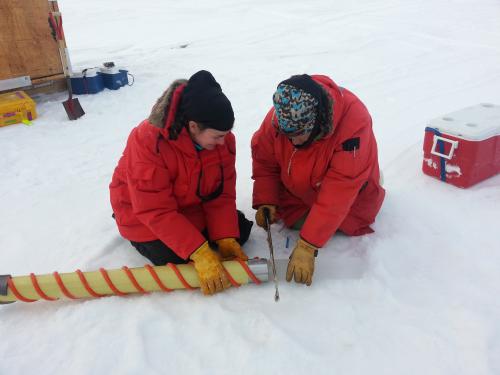All about the WAIS (not the treble)!
The Science of Wais Divide
About 11-12 years ago, a group of scientists, including Erin Pettit (my lead researcher for Velvet Ice), first came to scope out the site for drilling a WAIS Divide ice core.
An ice core is basically a round column of ice that is extracted by drilling it out of a larger ice body, like an ice sheet, glacier, or sea ice mass. For those of you who think in medical terms, an ice core is basically like a long needle biopsy of an ice sheet.

Ice cores can be a few feet deep or, as in the case of WAIS Divide, a couple of miles long!
What is important about an ice core is that it contains samples of each annual layer of ice in the ice sheet, for as far back as you drill.
WAIS Divide field camp was created specifically for the purpose of drilling an ice core. A community of about 80 people, including scientists, technicians, and field staff, contributed to the effort. It took 6 years, but by 2011, the ice core, measuring 3405m (~11,500ft), and representing 68,000 years of climate history, was completed.
http://science360.gov/obj/video/f6a9e6fd-de7b-4e57-b27d-3fbf30d37544/modeling-future-climate Video about the WAIS Divide Ice CoreA cylindrical section of ice removed from a glacier or an ice sheet using a specialized type of hollow drill. Enter the definition here. by the National Science Foundation.
Ice Cores have been a massive undertaking of the international scientific community, and have now been drilled around the world, wherever there is ice, including Greenland, the Himalayas, the NW United States, Canada, Scandinavia, and Russia, to name a few.
The data from all of the ice cores has been compiled and compared to give us a view of how temperature, CO2 concentrations, and other environmental conditions have changed around the globe over the past 850,000 years!
The one thing we can say with certainty, by examining data from all these parts of the world, is that, while there have always been periodic ups and downs, the overall trend shows that both temperature and CO2 levels in the atmosphere are rising. Second, we can say with certainty, that they are rising higher and faster now than anything we have seen in the past 800,000 years.

The WAIS Divide Ice CoreA cylindrical section of ice removed from a glacier or an ice sheet using a specialized type of hollow drill. Enter the definition here. is the newest addition to the growing body of information, data and knowledge that helps us understand the past and future of Earth's climate.
Now what?
So now that the Ice CoreA cylindrical section of ice removed from a glacier or an ice sheet using a specialized type of hollow drill. Enter the definition here. has already been drilled, and that project finished as of 2012, what's left?
Well, for starters, there is a 2-mile deep hole in the ice! It measures roughly 200cm in diameter, all the way down.
That 200cm worth of real estate (or more technically, pi*100cm^2 of real estate) is the reason that we flew 14,000 miles and spent one month struggling to get to WAIS Divide.
This hole, called a borehole, is the site for the first part of Velvet Ice's research.


Comments